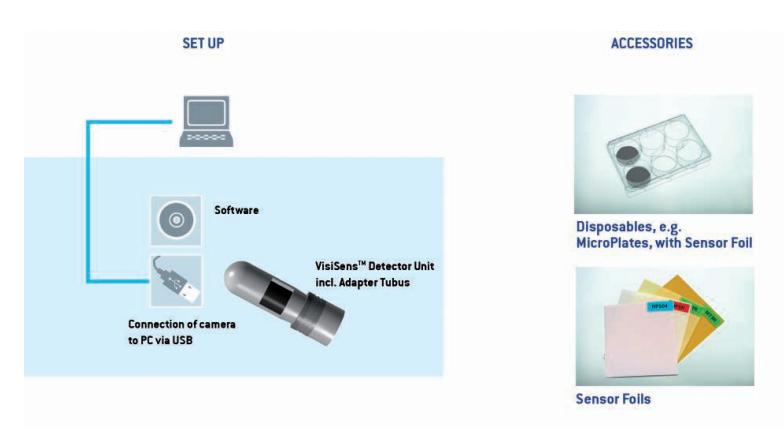Distributions in 2D for Biological Research
● Non-invasive mapping of metabolic activities
● Imaging of living samples
● Free choice of measurement conditions
● USB powered & portable device
● One device instead of thousands of individual sensors
Fluorescent chemical optical sensor foils combined with imaging technology allow easy 2D visualization of oxygen, pH or carbon dioxide distributions in heterogeneous samples. For measurement the sample surface is covered with the sensor film, which translates the analyte content into a light signal. The sensor response is recorded pixel by pixel with a digital camera. With VisiSens™ spatial and temporal changes of oxygen, carbon dioxide concentration or pH can be monitored.
Features
● Non-invasive mapping of metabolic activity using sensor foils
● Imaging of living samples
● Free choice of measurement conditions
● Reliable addressing regions with low or high O2, CO2 or pH
● More than 100,000 sensing points within one single image
● USB powered & portable
● Easy evaluation via image processing software
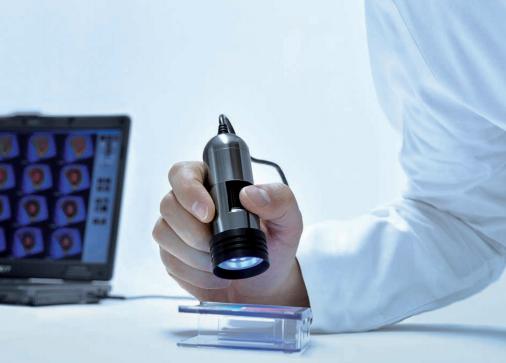 Software
Software
All software versions, whether for O
2, pH or CO
2 imaging, have the same user interface, so you only have to get familiar with it once to be able to work with all. The software allows controlling the image recording process, and assists image processing and evaluation. An easy to use camera controlling user interface manages image acquisition and storage. Measurements which belong together can be organized in user defined sessions as separate folders and annotated with a free text comment. Acquired images can be single images or automatically recorded time series.
 Benefits
Benefits
● Display the sensor response in false color image
● Display the actual pixel information
● Display ROI statistics of user defined polygon ROIs
● Interactive x- and y-axis profiles
● Z-axis profiles for plotting ROI average at defined coordinates
● Follow kinetics through a time series and display as 2D-plot
● Side-by-side image comparison of selected images
● Alpha blending of false color sensor response with color image
The Smart Measurement Method
luorescence Ratiometric Imaging (FRIM) is a method for reading out the signal of a fluorescent chemical optical sensor. Ratiometric measuring compensates most of the common interferences, e. g. inhomogeneous lightfields. An optical sensor foil contains an analyte sensitive dye and a reference dye which are immobilized in a permeable polymer matrix layer. The indicator dye is emitting red or green fluorescence, depending on the analyte and respective sensor foil type, which is dynamically quenched by the analyte while the reference dye is giving a constant green or red light signal respectively. These emissions meet exactly the red and green channel sensitivity of a color RGB chip.
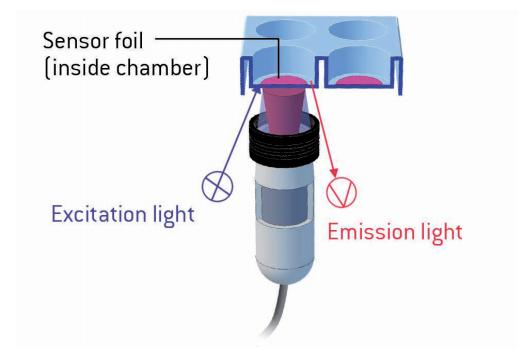 Visualized Respiration in Leaves
Visualized Respiration in Leaves
Plants are both producers and consumers of oxygen, while CO
2 is constantly produced. Visualizing O
2 and CO
2 levels on the surface of plant leaves can give important information about oxygen demand and CO
2 production during light/dark conditions. The sensor foils attached to the leaf surface seal it against oxygen or CO
2 from ambient air and translate the respective analyte level with high spatial resolution. During a continuing dark phase the oxygen concentration on the surface of a rose petal , for example, decreases (see images left). The leaf consumes oxygen, while it produces a higher level of CO
2. With VisiSens™ it is even possible to investigate different petal structures and compare them in terms of oxygen consumption. Findings in these experiments might be important information relevant for transport and storage of cut flowers.
 O2, pH, and CO2 Dynamics in the Rhizosphere of Crop Plants
O2, pH, and CO2 Dynamics in the Rhizosphere of Crop Plants
Research on metabolic activity of plant roots and determining the best cultivation conditions for optimal growth will be of major importance for sustainable agriculture, as e. g. water supply and fertilizing could be adjusted for the respective crop plant. 2D imaging with VisiSens™ is performed to visualize O
2 pH, and CO
2 dynamics in complex root systems and the surrounding media. With this easy-to-handle but extremely precise device metabolic processes and how they change can be monitored over long time periods; parameters responsible for changes can be determined. The acquired analyte maps for distinct root regions are quantitative and have a resolution in sub-millimeter range.
Blossfeld et al., Quantitative imaging of rhizosphere pH and CO2 dynamics, Annals of Botany 2013, in press
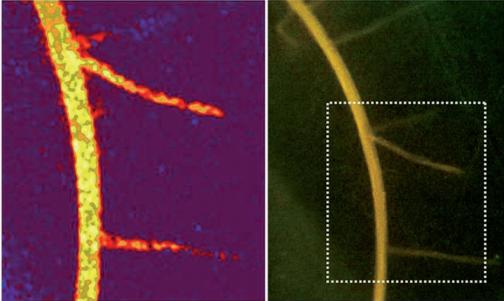 Visualizing O2, pH, and CO2 in Sediments
Visualizing O2, pH, and CO2 in Sediments
Oxygen, pH, and CO
2 are key factors and indicators for microbial activity in sediments. Microbial degradation of organic material under aerobic conditions can be detected in an increased oxygen consumption. With VisiSens™ high resolution images can be recorded detecting analyte dynamics in different sediments or sediment depth over long time periods. The portable device can be applied in the laboratory as well as out in the field. As experiment conditions can be changed during measurements the impact of changing parameters on microbial activity can be analyzed.
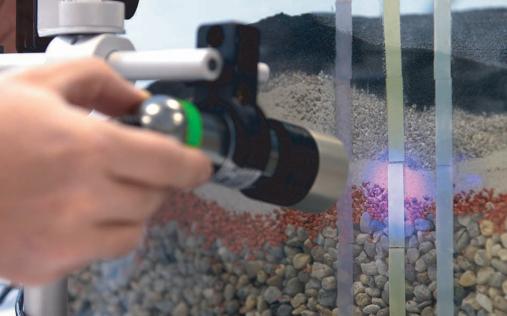 Controlling Microbial Biodeterioration of Historical Monuments
Controlling Microbial Biodeterioration of Historical Monuments
Historical monuments are often subject to microbial biodeterioration. Effective treatments that inhibit biological growth on ancient rock surfaces have to be found. Oxygen imaging with VisiSens™ allows determining the health status of e. g. lichen after biocide treatment and with it assessing the effectiveness of the biocide. This technique also allows for a direct in situ analysis of the health state of a small quantity of biological material on the facade of historical monuments or buildings. Showing fast results it can be implemented in evaluation studies and conservation.
C. Ascaso & J. Wierzchos: Assessing Biocide Actions on Lichen with
VisiSens, Oxygen in Action Competition Report, 2012
 Determination of Oxygen Gradients in Cell Culture and Engineered Tissue
Determination of Oxygen Gradients in Cell Culture and Engineered Tissue
Monitoring oxygen supply in cell culture or engineered tissue is very important. Especially cells towards the center of a culture can be subject to low oxygen levels. With VisiSens™ continuous, high-resolution oxygen measurements over cross sections of samples can be performed. The sensor foils can easily be applied in test or cultivation vessels, and samples are immobilized on top of the sensor. Measurements are taken non-invasively from outside the vessel, which reduces the risk of contamination. With its small footprint the VisiSens™ system can be mounted inside an incubator without any problems. Detecting oxygen gradients will allow taking measures, or apply new methods to avoid cell death due to hypoxia.
In upcoming studies hydrogels will be tested on their suitability as cell carriers in regenerative therapy. Oxygen releasing additives should sustain constant oxygen supply to the cultured precursor cells. VisiSens™ will be used to monitor the continuity and homogeneity of oxygen release and the actual oxygen supply of the cells.
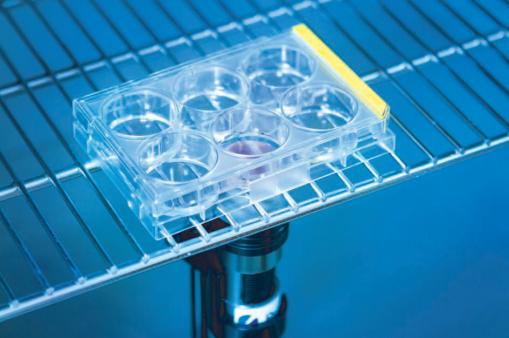 2D Imaging in Microfluidic Devices
2D Imaging in Microfluidic Devices
Microfluidic devices are an emerging technology in the Biotech sector. Due to many advantages as e. g. low fluid volumes, faster analysis and response times which allow better process control, and the compactness of the chips which enables massive parallelization, these devices gain in importance. With VisiSens™ it is possible to continuously monitor the important culture parameters oxygen, pH, or CO
2 now in high resolution over the whole chip surface. During development, this allows determining suitable culture device materials, e. g. for their oxygen permeability, according to application and cell line. Oxygen, pH, or CO
2 monitoring with VisiSens™ will improve
microfluidic device functionality even further, and it exhibits superior properties compared to similar sensing products.
C. Ochs, et al.: Cellular Oxygen Consumption in Microfluidic Devices,Oxygen in Action Competition Report, 2012
 pH Imaging in Skin Models
pH Imaging in Skin Models
pH imaging is an innovative method for investigating complex disease processes like e. g. wound healing and tumor biology. The pH of the wound fluid is known to greatly affect the healing process. Measurement techniques used so far have been very difficult to implement. The two-dimensional visualization of pH dynamics with VisiSens™ now allows monitoring spatially heterogeneous processes on skin models, which is a great advantage compared to single-point measurements with probes. Another future application of pH imaging will be tumor research giving insight in spatial and temporal changes of tumor metabolism.
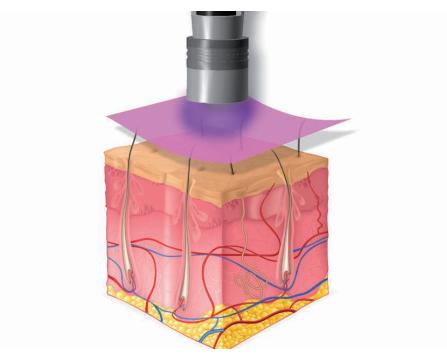
| Specifications |
Oxygen (blue) |
pH (red) |
CO2 (green) |
| Measuring range |
0 - 100 % air saturation
(0 - 20.9 % O2)
|
pH 6 - 7.5 |
0 - 1 % 1 - 25 %
|
| Response time** (t90) |
30 sec. |
30 sec. |
< 3 min. < 3 min. |
| Size of sensor foil** |
5 x 5 mm2
to 40 x 40 mm2 |
| Size of sensor foil** |
300 |
| Properties |
| Temperature range |
5 °C to 45 °C |
| Compatibility |
Aqueous solutions, ethanol (max. 10 % V/V), methanol (max. 10 % V/V), pH 2 - 10 |
Aqueous solutions, pH 4 - 9 |
| Device |
| Camera chip |
Enhanced Color CMOS |
| Image Resolution |
1.3 megapixel (1280 x 1024 pixels) |
| Magnification |
10-fold up to 220-fold, depending on adapter tubus used |
| Field of View |
~2.3 x 2.0 mm2 to ~4.1 x 3.3 cm2; typically ~ 1.5 x 1.2 cm2 |
| Output |
15 fps live video preview (no storage) and 0.5 fps full-resolution picture storage (.png) |
| Interface |
USB 2.0, high speed USB transmission |
| Number of LEDs |
8 |
| Material |
All-aluminum housing |
| Dimensions |
Length 10 cm, diameter 3.8 cm |
| Weight |
170 g (without adapter tubus) |
| *VisiSens™is no approved medical device |
| **typical data which may strongly differ with adapting the imaging set-up to specific needs |
